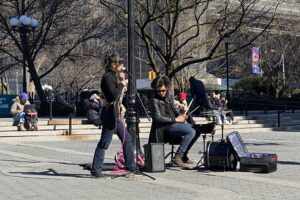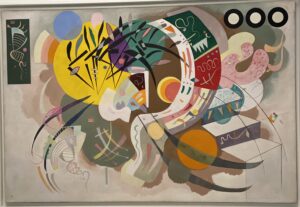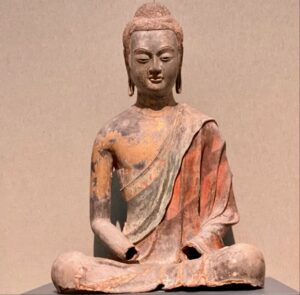New York 2022: Art, Food and Theater
New York is the first city I lived in when I moved from Toronto in Canada to the US in 1969. It was a welcome change from that provincial town (at that time). I had not adjusted well to it after spending a decade in London. Moreover, I came to a well-paying job and a comfortable apartment in the East Village that I had found on an earlier visit. Because of this history, coming to New York feels like coming home, my American home. My first stay in the city was for just two years, but I came back in 1978 for six more years, after graduate school in California, and lived in the West Village.

Union Square Band
Since then, I have come here regularly, especially after moving back to the East Coast a year ago. This was the first visit with New York more or less open for fully vaccinated people (we had to show our cards at museums, theaters and restaurants). I especially looked forward to sitting in a theater again and eating a nice meal at a restaurant (access to museums and galleries with timed entry had already been possible for the past year).
The play a friend and I picked to see ran for three hours, perhaps a little long for a first show in two years. “Prayer for the French Republic” took us through the lives of four generations of a Jewish family living in Paris, melding through marriage with a newly arrived Jewish family from North Africa. The newer Parisians were uncomfortable enough with the treatment of Jews in Paris to feel unsafe and wanted to move to Israel, whereas the established family felt French and wanted to remain. After much discussion, they decided to leave. I sympathize with feeling unsafe where I live. As a brown person I don’t feel safe in the US, especially after Trump let loose latent racism. The complex staging from the WW II period to the present, with sets moving around, was well managed and the acting flawless, but the last half hour was preachy and could have been cut. The New York Times reviewer said, “The play’s finale aims for the lofty and falls terribly short.”
The next evening, sitting at a bar drinking a glass of wine, I noticed a couple of men at the next table because the playbill for the play was prominently placed on the table. They were discussing a paper one had written. When I got a chance, I said I had just seen it too. It turned out that the author of the paper and I had attended the same performance. He was an Arab from Morocco married to a Jewish woman for thirty years and they were discussing the memoir he had written about their life.

Moghul Prince
In one of the several emails I receive daily from the New Yorker, I came across this reference to an art show: “Ages before Vasily Kandinsky began hearing colors and seeing sounds, painters in India were translating melodies into gem-bright miniatures, inscribed with poems, in a genre known as Ragamala (garland of ragas). Fourteen alluring examples—part of a series made around 1630 to 1650—fill a room in the wonderful show “Court, Epic, Spirit.” I managed to find the Luhring Augustine Gallery in Tribeca, and was delighted by several delicate, colorful, precise miniatures that lined its walls, even though I have a preference for abstract art.

Kandinsky
By coincidence the blockbuster art show in town was of Kandinsky’s paintings at the Guggenheim. Spiraling down from the top floor, from his early realistic period down to his colorful, imaginative, abstract work seemed to be a progression, but the museum’s notes say “His was not a fixed path from representation to abstraction, but rather a circular passage traversing persistent themes centered around the pursuit of one dominant ideal: the impulse for spiritual expression.” Kandinsky thought, “artwork … could counter the harm of materialism and introduce society to a more transcendent and communal way of being.” He came to studying art late, at the age of 30, after degrees in law and economics from Moscow University, and rejected an offer of an academic position. That gives me hope for a career in writing, after a degree in economics and an academic position too, but my first book was published somewhat later, when I was 80.
The Metropolitan Museum had several small exhibits to supplement its vast permanent collection. Most interesting for me was the “African Origin of Civilization”, which pays homage to Diop, the author of a book by that title. The exhibit has several pairs of statues from different African cultures and eras and ancient Egypt that show a deep historical connection even though there was no contact among the creators.
I usually walk through the Asia galleries, which also had three small exhibits: Japan: A History of Style showing the story of Japanese elegant and minimalist art with a range of artworks from ancient times to the present; Companions in Solitude: Reclusion and Communion in Chinese Art shows the tension between the two ways for cultivating the mind and art with images of people who took both paths or wove them together; and Bodhisattvas of Wisdom, Compassion and Power, shows a range of art and objects from monasteries in Nepal and Tibet venerating these three bodhisattvas that played an essential role in the introduction of Buddhism to Tibet. One statue caught my eye, a Buddha of Compassion.

Buddha of Compassion
At MOMA, in addition to the permanent collection, I visited two exhibits: Sophie Taeuber-Arp’s geometric abstract work in many mediums ranging from paintings, furniture, textiles, household objects and more. She succeeded in her objective of making colorful, living things in a modern style; and the Post Colonial Architecture in South Asia, which surveys the work of local architects in Sri Lanka, Pakistan, India and Bangladesh beyond the work of Corbusier and Louis Kahn. I had seen many of the buildings in India, and was struck by the equally imaginative work in the other countries.

Jennifer Packer
The Whitney has several floors blocked in preparation for its forthcoming Biennial exhibition. A selection of the permanent collection was available, including works by Jasper Johns and Georgie O’Keefe. Two exhibits were also on view: Jennifer Packer’s work that included a couple of huge paintings. Her portraits of friends, family, and flowers combine still life with abstract representation; and Women and Abstraction, during the 1930s and 1940s, as abstraction began as an exciting approach to modern art in the US, a number of artists in this emerging genre were women, and their efforts added to its evolution. The exhibit highlights the achievements of these artists.

Jennifer Packer
As restaurants were open to fully vaccinated people, I was eager to try a few from a list a knowledgeable friend had provided. I had lunch at The Modern, not in the white table-cloth, prix fixe ($150) Michelin starred side, but the bare tables side, with an a la carte menu, though still with excellent service. I had eaten here several years ago. I started with a Flambé Torte, which turned out to be a thin flatbread with flakes of ham and onion on melted aged cheddar, I believe. Not bad but not memorable. The crispy skinned thick portion of salmon on a bed of warm potato salad was served with boiled halved radishes and a basil leaf, swimming in a buttermilk and olive oil sauce. Only the skin was crispy, but the salmon was pink on the outside and red at the core, just how I like it. With it, I had a glass of Prua Pigato from Liguria. I have never had this grape before. It was softer than a Chardonnay, but still velvety with a citrus finish. It paired surprisingly well with the Salmon with which I usually prefer a Burgundy or Bordeaux. The waitress gifted me an unusual sorbet that brought the meal to a satisfying close. It had a chopped coconut base with a hint of ginger, and was topped with chunks of pineapple sprinkled with tiny specks of iced salt. Next time, the dining room for sure.
I dined at Marta with a friend. We shared a Grilled Octopus with fried Chick Peas, Citrus, Celery and Chili Crisp. The citrus slices and chili made for an interesting mix of flavors with pieces of the grilled octopus. We followed the starter with an excellent, thin crust Fungi Pizza with Hen of the Woods, Fontina, Mozzarella, Red Onion and Thyme–so much better than Lia’s, my local eatery that offers a similar pie. The house Pinot Grigio from Friuli was light and aromatic, but the house Red, a Negroamaro from Puglia, was thin and tasteless. The atmosphere was youngish and very lively. I would go back, but order a different red wine.
At Balthazar, I made the mistake of dining in their roadside tent rather than in the very French looking bistro inside. I had a portion of the Pan-Seared Halibut with grilled asparagus (one), oven-dried tomatoes, olives, in a saffron sauce. The fish was prepared perfectly, flaked off easily in segments, but I wish they had served some creamy mashed potatoes to sop up the sauce and perhaps more asparagus. With it, I had a Simonnet-Febvre Chablis, lighter and cleaner than its California cousins, with a melon, lemon finish, adding flavor to the white fish. The waiter gifted me a glass of bubbly, their tradition for single diners, a nice touch.
Another friend provided a suggestion for a modern Greek dinner at Nerai, which was not a success, unfortunately. It was situated near MOMA and well appointed with white table-cloths atop tables and well-dressed waitstaff, polite and attentive. We shared a starter of Kataifi Shrimp, three Tiger prawns wrapped in Kataifi (a dough made of a mixture of flour, cornstarch, salt, oil, and water), with Sansho Peppercorn and Greek Honey, which, despite the yummy description, needed the sweet chili sauce that came with it. It was the best part of our meal. My overdone, soggy squid ink pasta in Metaxa (aromatic Muscat wine) bisque drowned the taste of the poached lobster medallions: I ate those and left most of the pasta. My friend fared better with Lavraki (whole grilled Loup de Mer (seabass)), deboned and filleted, served with sautéed spinach). My Tselepos Marmarais Chardonnay was oxidized, tasted off, and my friend’s Biblia Chora Sauvignon Blanc, both Greek wines, was barely potable.

View from Reservoir
It is always a pleasure to walk in New York, starting with a round or two of the Reservoir in Central Park, while munching on a toasted onion bagel, despite a cold wind at times. The Metropolitan, Guggenheim and Modern Art museums were all a manageable stroll from my rental apartment. The Whitney though needed a subway ride and a nice walk from Union Square along 14th Street to the Meatpacking district where I found a showroom for Lumina, a beautiful new electric car, and further south, the Luhring Augustine gallery.
